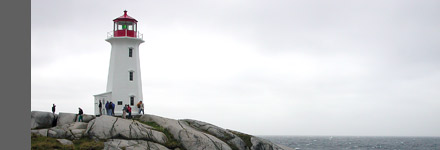
| Halifax, Nova Scotia |  |

The Nova Scotia flag depicts the heritage of the people of this province. It is based upon the Ancient Arms of Nova Scotia, granted by King Charles I in 1625. The background of the flag is an extended blue cross on a white background, a reversal of the colors found on the Cross of Saint Andrew, symbolizing Nova Scotia's links to Scotland. In the center of the flag is a Royal Lion set within a double red border on a yellow or gold background. This was the first flag to be flown in the Commonwealth outside of Great Britain.
![]()
Oh boy, we were advised to bring clothing for rain for our stop at Halifax. Sure enough, it was foggy and raining when we arrived. We brought our raincoats and umbrella so a little rain wasn't going to stop us. Our trip to Peggy's Cove was just after lunch so we walked out into Halifax to their local “Farmers' Market” which turned out to be an interesting place to roam. There was a brewery there, many stands of fresh vegetables, very fresh, some local crafts and places to eat. There also seem to be a lot of local people there so it wasn't a tourist trap.
Outside it was cold and wet. We grabbed some sushi, went to a coffee shop and headed back to the ship. Soon, we were on a bus to take us to Peggy's Cove.
According to legend, Peggy's Cove was named after the only survivor of a schooner that ran aground and sank in 1800...a woman named Margaret. Local folk called her "Peggy" and her home came to be known as Peggy's Cove. Two stories are told as to how Peggy's Cove got it's name. The first speaks of a schooner that ran aground on Halibut Rock, just off the lighthouse point, one dark and stormy October night. To escape the strong waves which washed the schooner's decks, many of the crew climbed up the masts but it did not take long before they were swept to their death into the raging sea. All hands were lost to the sea except for one woman who swam ashore and was rescued by the people of the Cove. Her name was Margaret and she remained in the Cove and married a resident. People from nearby communities would frequently come to visit Margaret, who became known as the diminutive "Peggy of the Cove," and hear her story of being the lone survivor of the shipwreck. It was during these early years that people began calling the Cove Peggy's Cove.
The second story is based on geography and it is simply due to the Cove's close location to St. Margaret's Bay. It is thought that because the Cove is situated at the entrance to the Bay that people referred to the area as Margaret's Cove, which eventually became the more intimate name of Peggy's Cove.
It has been only recently that proof has surfaced making the first story factual. A lady came to Nova Scotia with documentation proving that Peggy was her grandmother and that she was indeed the lone survivor of the shipwreck.
Peggy's Cove is one of the most photographed location in northeast Canada. I took my share. The sixth photo below is part of a skull of a whale.
Back to Halifax and we passed by this bridge. It was in this area that a huge explosion took place in December 1917. It was the largest man-made explosion to ever occur. The harbor was crowded with ships loading to provide war supplies to England. A French ship was laden with explosives and the unthinkable happened. I suggest that one take the time to read about this tragedy at web site. It is a pretty amazing story with assistance coming all the way from Boston.
Everyone was on board and we were preparing to leave. The weather had improved greatly and providing the opportunity to take photos that we could not see that morning. Then along comes this container ship and we had to wait, and wait and wait, until it had passed.
Seldom does a Princess ship require the assistance of tug boats. These cruise ships have side thruster that can push the ship into or away from a pier or wharf.
![]()
| Return to Home Page | ||
| Quebéc | Saguenay River | Halifax, Nova Scotia |
| Saint John, New Brunswick | Bar Harbor, Maine | New England & NYC |